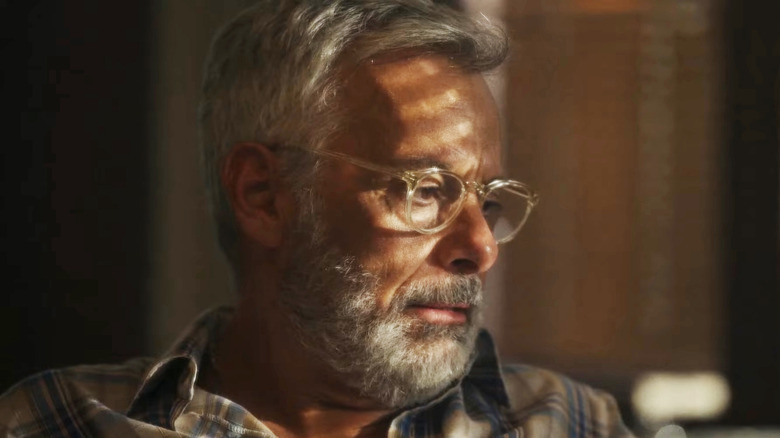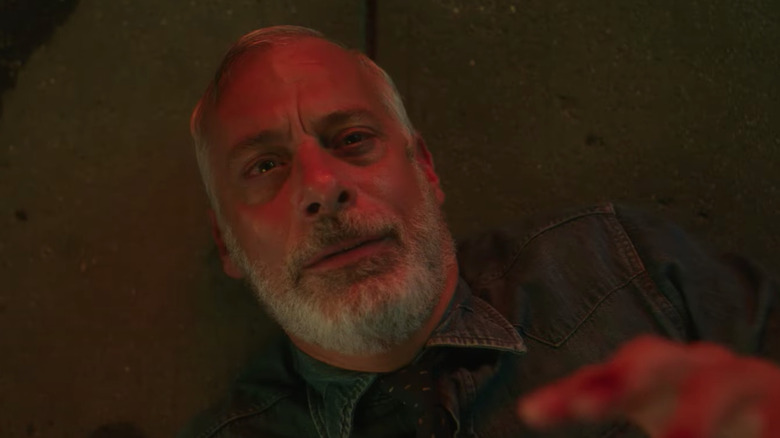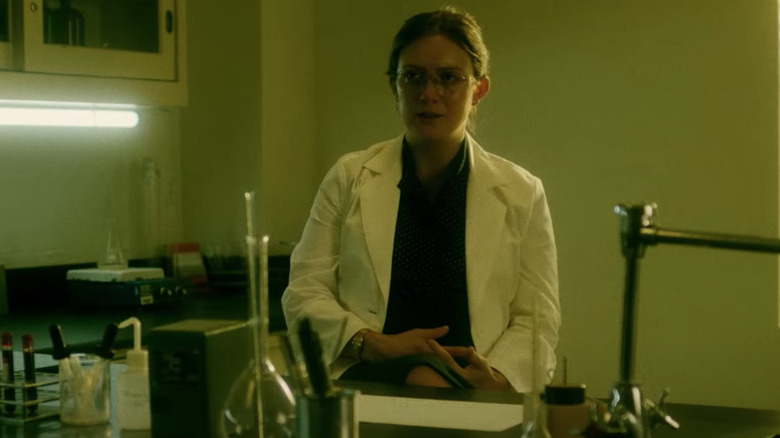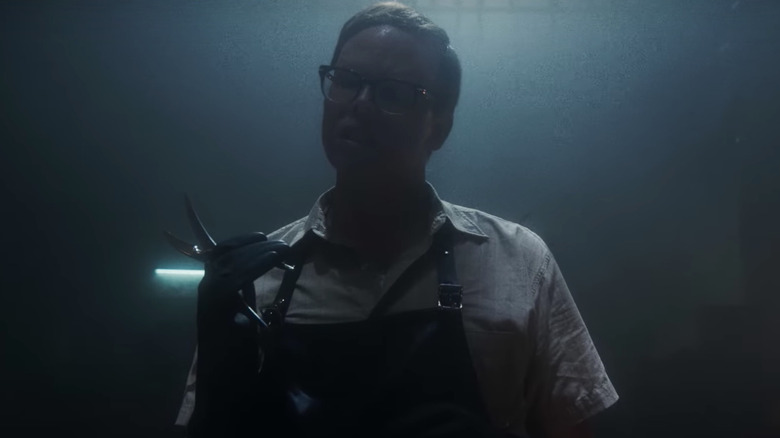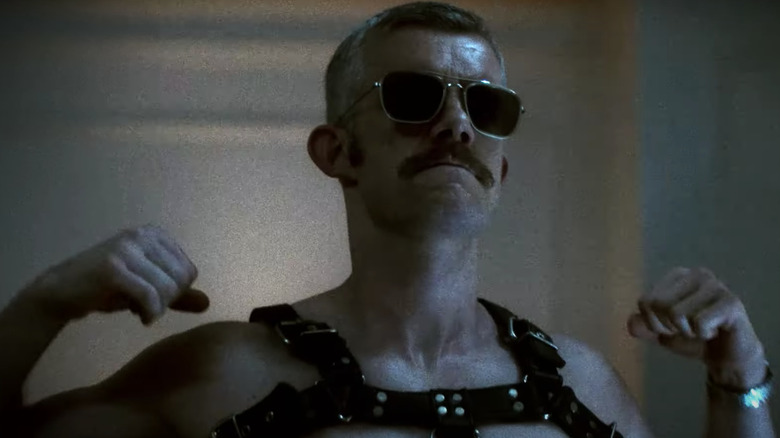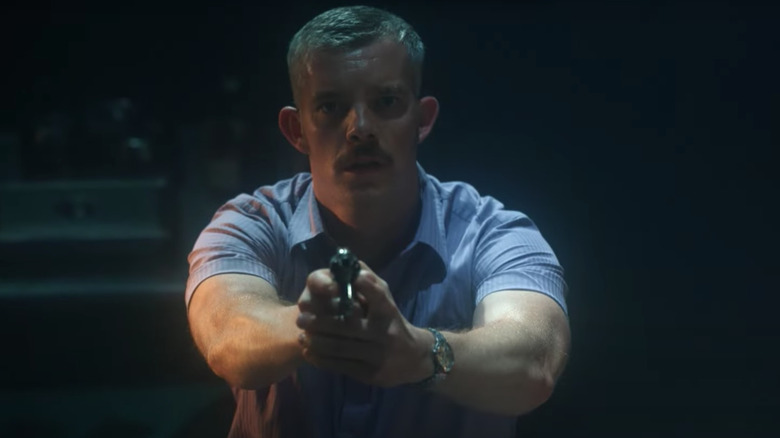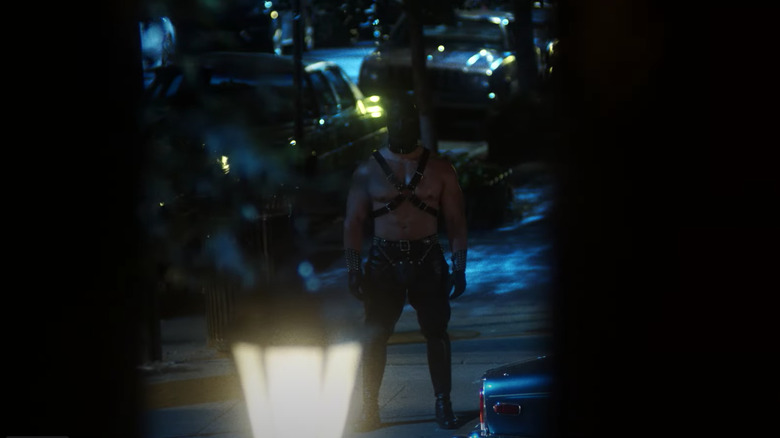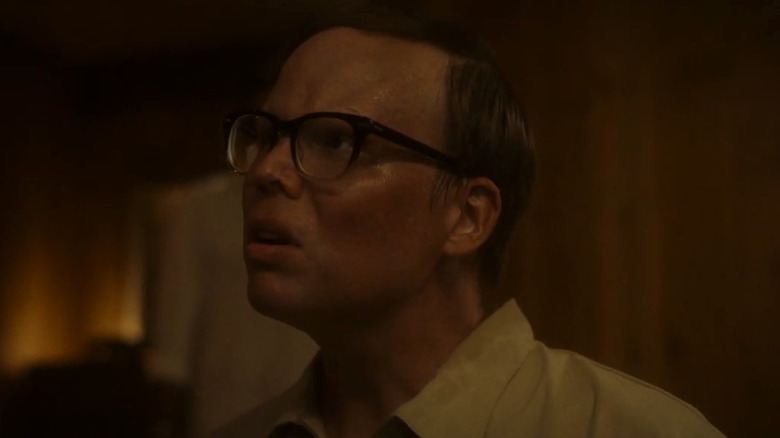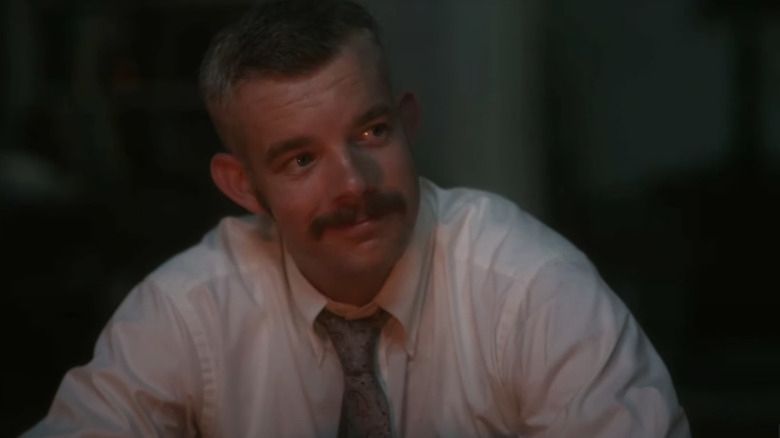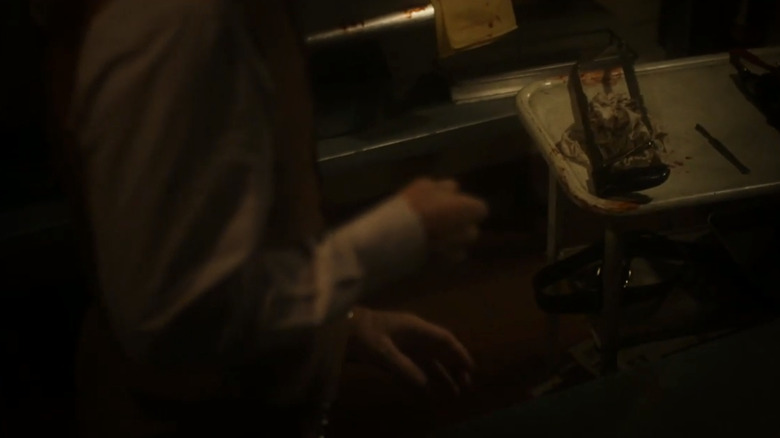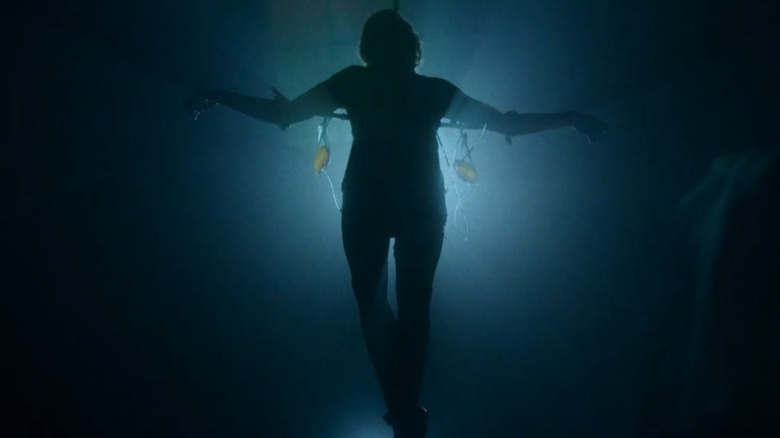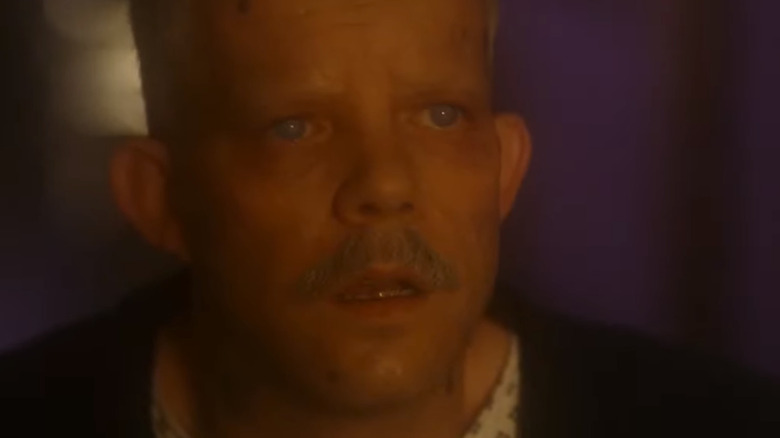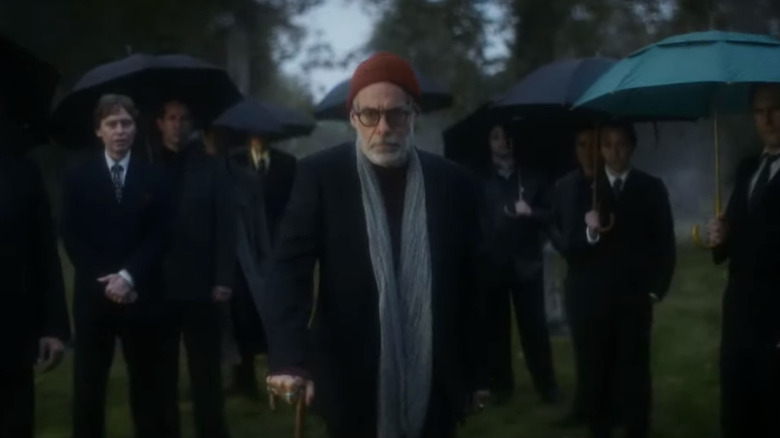12 Most Disturbing Moments From American Horror Story: NYC
Season 11 of "American Horror Story," "American Horror Story: NYC," offers viewers a truly disturbing tale. This season, the series focuses on the city that never sleeps, where terrifying killers stalk an unsuspecting slew of victims. And that's not the only problem haunting the Big Apple. As the mysterious Big Daddy and the elusive Mr. Whitely (Jeff Hiller) hunt their prey, another deadly entity sweeps the city: A mysterious infection, which causes suspicious markings to appear on sufferers' skin. This harrowing illness leads Dr. Hannah Wells (Billie Lourd) down a sinister rabbit hole of investigation. After a pack of deer are infected, Dr. Wells' complex research uncovers even more strange findings.
The entire bloody affair is fascinating, terrifying, and brimming with social allegories. Reddit boards and Twitter threads alike have bustled with feverish fan discussion following each tantalizing episode. Notably, "American Horror Story: NYC" also returns the series to realism with its gruesomely true narrative. The NYPD's finest mishandle the case and fall prey to bigotry, leading to countless more senseless deaths. Haunting parallels to Jeffrey Dahmer's unsettling killings soon emerge. And then, of course, there's the season's wider allegory of the AIDS epidemic. It all culminates in an arresting assortment of horrifying moments. These are the 12 most disturbing — if you've got the guts to revisit them.
Whitely's use of needles
Unlike previous seasons of the celebrated horror anthology series, viewers aren't treated to any ghosts or killer clowns in "American Horror Story: NYC." Instead, they watch deranged psychopaths and power-hungry sadists do their absolute worst. The show makes this clear right off the bat in Episode 1, "Something's Coming," when Gino Barelli (Joe Mantello) gets a first, foggy glimpse of the unhinged Mr. Whitely.
Whitely kidnaps Gino after drugging his drink (a nod to the infamous Jeffrey Dahmer, especially coupled with Whitely's strikingly similar glasses). Then, he subjects him to heinous and stomach-turning torture. Whitely plans to rip Gino apart and use his dismembered body for a twisted project. However, when he sees Gino's military service tattoo, he sets him free. Before we're able to breathe a sigh of relief, however, Whitely excruciatingly mutilates him. He sterilizes syringe needles with heat, then injects them into the very tips of Gino's fingers, under his nails. The cringe-inducing nature of this violence is brought home with an unflinching close-up of the injections. This early scene is a grave warning sign that meticulous Mr. Whitely is a seriously disturbed force to be reckoned with.
Shooting the infected deer on Fire Island
The slaughter of an entire pack of unfortunate deer acts as an early metaphor for the lives tragically lost to the fast-spreading illness at the center of "American Horror Story: NYC." As Dr. Wells' research uncovers more and more chilling details, we learn that common ticks are responsible for carrying the blood-borne infection. This results in the mass shooting of the deer who could act as spreaders.
It's a heartbreaking sequence — but that's not all it is. This moment also explains how humans became infected with the disease in the first place, and why gay men are being so heavily devastated: The deer live on Fire Island, a community haven. This makes the fact that it might be a targeted conspiracy even more infuriating. But of course, the illness also attacks heterosexual cisgender citizens like Dr. Wells and Patrick's ex-wife Barbara (Leslie Grossman) in the form of Big Daddy. His presence turns out to be a metaphor for the horrific and all-consuming AIDS epidemic, making their deaths at his hands an allegorical representation of the disease. These deaths are tied to those first, unfortunate deer by the antlers victims are adorned with as Big Daddy sends them to their very early graves in the season finale.
Whitely's gory chain of hands
In one of Whitely's darkest acts, the Mai Tai Killer earns his eerie moniker by leaving a bold message for the New York Police Department. Before we're privy to the odd butcher's past, he strings a strand of hands together in a truly disturbing fashion. This gory image ends the two-part premiere in a very memorable way. It's also an early indicator that Whitely has a penchant for dismemberment, which is further explored in subsequent episodes.
Whitely takes the hands of five different men to gloat over the complacent officers who fail to find him. As he confidently tells Gino when he kidnaps him, because of the nature of his crimes, the cops have no interest in looking for him, even if it is their technical duty. This simultaneously draws more real-world comparisons to discrimination and bigotry against the LGBTQ community, while adding another frightening layer to Whitely's self-aware intelligence. He utilizes this "advantage," along with his whiteness, to stay one step ahead of the officers as he performs his hideous acts. When his abominable plan becomes clear, it's distressing to say the least — all the more so because he easily could have been stopped if anyone had bothered to do their jobs.
Patrick brutally whips a man
Patrick Read's (Russell Tovey) darker side comes out of hiding in a particularly gruesome scene involving a very unfortunate victim. His ex-wife Barbara confronts Gino about Patrick's hidden BDSM apparel, which prompts an undercover investigation at the local leather bar. Among the colorful bandanas and bondage gear is a mask that is strikingly similar to the one Big Daddy wears. Though Gino is deeply bothered by yet another one of Patrick's lies, he seizes the opportunity to further the case, with unsettling results.
"American Horror Story: NYC" depicts Patrick's inner turmoil in a shockingly violent way. He meets an innocent young man as he's scouting out the establishment, and quickly escalates the situation into something far more alarming. In his search for Big Daddy, Patrick fully inhabits his most bloodthirsty tendencies, and mercilessly whips the man over and over again. While the camera may spare us from the full violence of this grisly act, we can't escape the way it sounds. The hideously wet strikes go on and on and on, until you wonder if they might never end. This prolonged suffering reiterates the season's gritty commitment to realism: Patrick is discontented, and he's expressing it in a horrifically visceral way. The act also highlights his suspicious nature, which leads some "American Horror Story" fans to think Patrick may be one of the season's sadistic killers.
Patrick executes Whitely and Big Daddy
In two scenes that produce some seriously complicated emotions, Patrick seemingly eradicates both of the season's killers by similar means. All hope seems lost as Patrick, handcuffed to a metal operating table, grows increasingly restless and fearful. He has good reason to do so: Whitely plans to cut out his still-beating heart and incorporate it into his sick Sentinel project. But then Patrick's eyes grow wide, and his rage builds. Once he earns his freedom, he's able to unleash this wrath.
In Episode 7, "The Sentinel," Gino and the smart-mouthed Henry Grant (Denis O'Hare) are able to escape Whitely's malevolent clutches, thanks to a surprising act of self-sacrifice on Henry's part. When they regroup with Patrick and finally have Whitely at their mercy, Patrick hastily makes an irreversible decision. He tells Whitely that he's the one who desperately needs redemption, while he envisions the stolen souls at the killer's side. His anger takes over as he raises the gun and splatters Whitely's brains on the lamp behind him, which illuminates the gore. Patrick intentionally robs Whitely of any chance of redeeming himself while simultaneously hijacking Gino's ability to get justice.
We see this again in Episode 8, "Fire Island," when Patrick desperately tries to save Gino and Adam Carpenter (Charlie Carver) from Big Daddy. He shoots him execution style with a single bullet to the back of the head. But in an unfortunately unsurprising turn, the leather-clad strangler is nowhere to be found when they look for his body a little while later.
Big Daddy burns the Ascension Bar
Just as Adam is beginning to find a sense of home and belonging in the gay community, it's viciously ripped away by Big Daddy. Adam is invited to an exclusive gay club called the Ascension Bar by his potential new boyfriend, Theo Graves (Isaac Powell). He's nervous, but excited. His last relationship ended in tragedy, which put him on a similar path as Gino.
In Episode 3, "Smoke Signals," he's greeted by Dunaway (Sis), the stylish lounge manager, who effortlessly leads the way through all the glamorous exclusivity. After Theo arrives, they have a tense conversation. Once it subsides, they receive an ominous drink from a stranger at the bar. The drink is a cheeky Mai Tai from the killer himself, Whitely. He quickly slips out the back, but not before locking the doors, trapping them all inside. The captives frantically realize what's happened, and try to pry the chained doors open. That's when Big Daddy suddenly launches an incendiary Molotov cocktail through the door.
This vicious hate crime draws stark parallels to tragic real life events, like the 1973 destruction of New Orleans' UpStairs Lounge and a hideous act of arson committed against New York nightclub Rash in 2022. Big Daddy embodies the relentless bigotry faced by the LGBTQ community, and it makes him all the more disturbing.
If you or a loved one has experienced a hate crime, contact the VictimConnect Hotline by phone at 1-855-4-VICTIM or by chat for more information or assistance in locating services to help. If you or a loved one are in immediate danger, call 911.
Billy's tragic fate
Episode 6, "The Body," is a ghastly addition to this season that unearths Patrick and Sam's (Zachary Quinto) unspeakable past. Their shared history comes to light when a skeletal body is uncovered on the beaches of Fire Island. From start to finish, this sequence is overflowing with menace.
While Fire Island is known for being a safe space for the gay community, it's also depicted as a party-heavy getaway spot where almost anything goes. This is taken to extremes with Patrick, Sam, and a boy named Billy (Danny Kornfeld). The three men consent to have sex. As Sam and Patrick fall deeper and deeper into a drug-induced haze, their inhibitions fade away. Soon enough, they forget about poor Billy, who tragically suffocates.
This sudden death brings in Henry and Whitely as Sam recruits a clean-up crew. Henry is revealed to be a hitman, while Whitely is his blackmailed assistant, forced to do the dirty work. He braces himself for the horrendous task, then begins chopping up Billy's corpse. Whitely's self-reflection over Billy's body leads to the psychotic break that births the Mai Tai Killer, who's driven by an unquenchable passion for severely misguided justice. The revelation that these senior members of the community had a direct hand in creating the Mai Tai Killer is appalling and darkly ironic.
Patrick's dark secret
What's even more disquieting than Billy's dreadful death? Patrick's ability to lie through his teeth about it and put on an apparently sincere smile. Though the season finale of "American Horror Story: NYC" paints a far more empathetic picture of the former NYPD detective than viewers might expect, it's hard to imagine him being able to live with Billy's death in a healthy way. How could someone perpetrate something like that and not harbor a certain degree of darkness within himself? But while Sam is outwardly cold and hardened, Patrick attempts to present a personable front.
Patrick's conflicting feelings are symbolized by both Big Daddy himself and Whitely's Sentinel, whose actions drastically contrast each other. Big Daddy, an allegorical representation of the AIDS epidemic, kills without discretion, while the Sentinel is a protector and guardian of LGBTQ people in need. Big Daddy's wardrobe also mirrors Patrick's vicious alter ego, which is put on full display when he whips the man in the bar. Additionally, his vengeful and cold-blooded actions — shooting Whitely and Big Daddy among them — parallel the Sentinel's vindictive behavior. Thus, his dark secret is dragged disturbingly into the light.
Henry's bloody sacrifice
In a surprisingly selfless move, Henry cuts his hand off to free himself and Gino from Whitely's torture chamber. To make matters even more touching, he does this soon after professing his love for Gino. It's tender, touching stuff ... and also hideously violent. The scene maximizes the gore factor by focusing on the river of blood that gushes out of Henry's wound as he saws through his own bones.
This shocking scene might bring back memories of movies like "Saw" and "Hostel" in the most horror-savvy fans, and not just because of the violence itself. This nightmare is about the injury and the fact that it requires Henry to go into it with thoughtful intent. When Henry looks over at the bloody hacksaw and knows he has no other choice, a chill races down every fan's spine. He doesn't get the minor blessing of ignorance — he knows intimately what he must do. Henry picks up the deadly instrument and immediately starts cutting.
This is one of the most effective scenes of horror in all of "American Horror Story: NYC," because it showcases the frightening capabilities that lie dormant within humanity. Series veteran Denis O'Hare is the perfect vessel for this excruciating moment: He gives his character a refreshing layer of development, depth, and nuance as he performs the unthinkable.
Whitely's sickening Sentinel
The unveiling of Whitely's upsetting and monstrous Sentinel cuts deep. This creature resembles Frankenstein's infamous monster, and fails to symbolize what Whitely intends it to. Rather than bring awareness to the crushing suffering and persecution LGBTQ people face, the Sentinel is a creature of pain. Specifically, it's an encapsulation of the pain Whitely caused by slaughtering so many innocent men.
This bloody metaphor proceeds to make a statement of its own in a creepy dream sequence that sees Whitely's sick fantasies come to life. This scene unfolds over Gino's moving monologue about the opposing forces of pride and death in the gay community, which highlights the virtue Whitely tried to pursue. In a justified rage, the Sentinel violently protects the LGBTQ community by saving a young boy from hateful violence, a sex worker from a depraved man, and numerous other people. It does, in short, what the police willfully won't. Gino underlines that the Sentinel may be the symbol of pride they need now, as the infection claims more and more lives, rather than a more commercialized or flowery version.
Sam and Patrick's divergent fates
A two-part finale ends "American Horror Story: NYC" on an extremely somber note by depicting the AIDS crisis with painstaking honesty. Our main cast dwindles as Big Daddy and the infection he symbolizes claim their lives, leaving only Sam, Patrick, Gino, and Adam. In "Requiem 1981/1987: Part One," we see Theo perish much like Billy did. He returns to guide Sam through the ghosts of his past, as in "A Christmas Carol," ending on his current state.
Sam, ravaged by the disease, is experiencing his final exhausting days alone in his hospital room, with no one to love or mourn him. He's lived a shallow and self-centered life and is now paying the price for it. This contrasts with Patrick who, in spite of his new blindness, is still surrounded by those who care for him, like Gino. The astonishing turn these towering figures have taken is heartbreaking and reflective of the real-world toll of the AIDS crisis.
The AIDS crisis' devastating toll
"American Horror Story: NYC" encapsulates the heart-wrenching tragedy of the AIDS crisis with a beautiful musical montage that tracks Gino's mission to raise awareness after Patrick's untimely death. The finale, which might be one of the best "American Horror Story" episodes ever, replicates true events like the "Die-In" protests (via History) of the era, which exposed political leaders' consistent neglect and indifference.
This season's dedication to realism pays off immensely in this moment. The disturbing horror of "American Horror Story: NYC" lies in our own history, and the enormous loss of innocent life that the AIDS crisis caused. We feel this most profoundly in Mantello's commendable performance as Gino. He portrays an unwavering determination to find a cure, in spite of bigotry, cruelty, and shame. As Kraftwerk's "Radioactivity" plays, the sequences ends on a mournful note. This is a departure from the sensational recipe of thrills and chills fans expect from "American Horror Story," but it's a necessary one.
